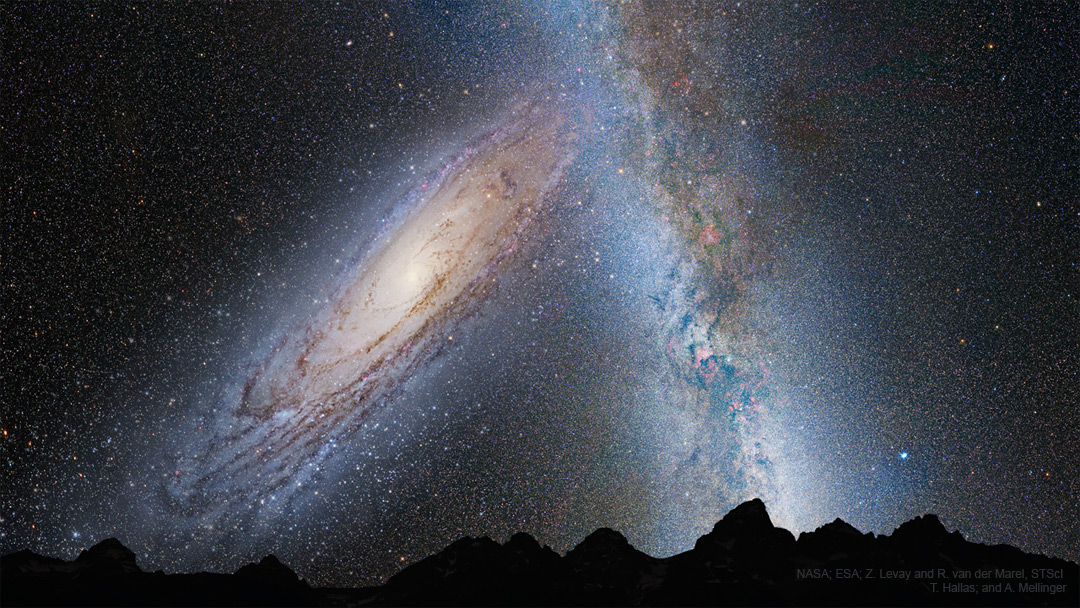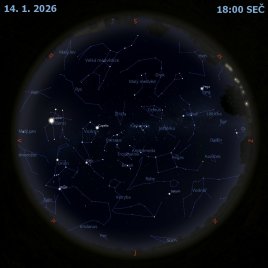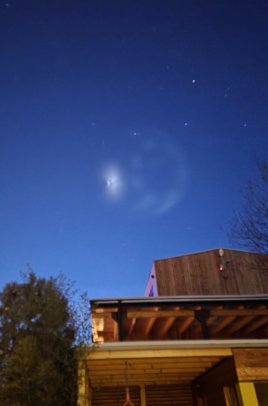Galaxie Mléčná dráha odsouzena k zániku: Čeká nás srážka s Andromedou

Uznání: NASA, ESA, Z. Levay and R. van der Marel (STScI); T. Hallas; and A. Mellinger
Srazí se naše Galaxie Mléčná dráha jednoho dne se svým větším sousedem, s Galaxií v Andromedě? Nejspíš ano. Pečlivé měření malých posunů hvězd v M31 vůči galaxiím pozadí na nedávných snímcích z Hubblova kosmického dalekohledu ukazuje, že střed M31 by mohl být na přímém kolizním kurzu se středem naší domovské galaxie. Nicméně se zdá, že chyby v bočních rychlostech jsou dostatečně velké na to, aby připouštěly dobrou možnost, že se centrální části obou galaxií sice mírně minou, ale přiblíží se natolik, že se jejich vnější hala gravitačně propletou. Jakmile se to stane, tak budou obě galaxie svázané a v příštích několika miliardách let budou spolu tančit, až se nakonec sloučí do jedné velké eliptické galaxie. Na obrázku je vidět kombinace snímků představující oblohu nějakého světa (Země?) ve vzdálené budoucnosti, kdy se vnější části každé galaxie začínají srážet. Budoucnost naší Mléčné dráhy a celé okolní Místní skupiny galaxií zůstane nejspíš dlouhá léta předmětem aktivního výzkumu.
Seznam odkazů v popisu
- Harvard.edu: The M31 Velocity Vector. I. Hubble Space Telescope Proper-motion Measurements
- APOD: 2009-05-25 Hubble zase volný
- NASA: Astronomers Predict Titanic Collision: Milky Way vs. Andromeda
- NASA: What Is a Galaxy?
- Harvard.edu: The M31 Velocity Vector. II. Radial Orbit toward the Milky Way and Implied Local Group Mass
- APOD: 2021-10-04 NGC 4676: Když se srazí Myši
- Blogspot.com: Foto: cats+entangled :-)
- Youtu.be: Milky Way's Head On Collision
- Harvard.edu: The M31 Velocity Vector. III. Future Milky Way M31-M33 Orbital Evolution, Merging, and Fate of the Sun
- NASA: Illustration Sequence of the Milky Way and Andromeda Galaxy Colliding
- Wikipedia: Elliptical_galaxy
- NASA: NASA's Hubble Shows Milky Way is Destined for Head-On Collision
- Harvard.edu: The collision between the Milky Way and Andromeda
- Wikipedia: Local_group_of_galaxies
- arXiv.org: The collision between the Milky Way and Andromeda and the fate of their Supermassive Black Holes
NASA Official: Phillip Newman Specific rights apply. NASA Web Privacy Policy and Important Notices
A service of: ASD at NASA / GSFC & Michigan Tech. U.
Odkaz na originální APOD


